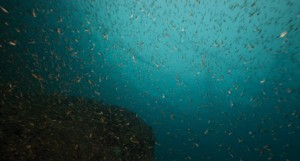The only way is up

Zooplankton migrate and aggregate in surface layers during night. In this case a swarm of Mysis sp photographed in situ on Svalbard. Photo: Geir Johnsen (NTNU).
Diel vertical migration (DVM) of aquatic organisms is a global phenomenon, characteristic of both marine and limnic environments. Collectively, this phenomenon constitutes the largest synchronised movement of biomass on the planet. In principle, DVM is a behaviour regulated by light, in which organisms migrate up into the surface layers of the water column to feed at night when they are inconspicuous to potential predators. Then, as lights returns, and potential predators become more likely to find them, these organisms migrate down into the safety of the darkness at depth. In effect, by feeding at surface and respiring at depth, it is also a major constituent of the biological carbon pump, removing biologically bound carbon from the surface and releasing it as CO2 at ocean depth. With the Arctic Ocean’s substantial ice cover, low temperatures and short phytoplankton bloom season, this means that the region sequesters atmospheric CO2 at a rate below the global average. However, a widespread and continued decrease in sea ice cover has the potential to increase primary productivity and the associated carbon drawdown. As such, the process is of major importance both biologically and from a climate perspective, and due to the inevitable unique light climate at high latitudes, the Arctic constitutes a massive field laboratory in which this process may be of enhanced importance.
Marine ecosystem processes are direct consequences of complex behaviours and interactions between organisms, many of which are driven by the physical environment. Accordingly, the classic paradigm of Arctic marine ecology suggests that most biological processes stop during the polar night at high latitudes due to low food availability and a lack of light. Recent research carried out in the Svalbard archipelago has challenged this assumption by presenting evidence of both active and synchronised DVM of zooplankton during the polar night. Although the polar night at these latitudes is perceived by the human eye as having continuous and total darkness, new data nevertheless indicate that Arctic zooplankton respond to variations in the very low light levels. Also, and although patterns of DVM have been documented at high latitudes, rather little knowledge exists regarding which species perform this ecologically important behaviour. In the Arctic, the vertically migrating components of the zooplankton community are usually regarded as a single layer of organisms performing synchronised patterns of migration directly controlled by ambient light.
New data from the Circa and Marine Night projects provide evidence for the hitherto unknown complexity of Arctic marine systems, where zooplankton form multiple aggregations through the water column. Whilst the initiation of DVM seems to be light mediated, the vertical positioning of migrants during the day is linked more to the thermal characteristics of water masses than to irradiance. Considering the large and pronounced changes that are currently occurring in the Arctic, with strongly reduced ice cover and increased temperatures, this may therefore significantly impact on how climate change affects the Arctic ecosystem, not only because less ice will increase the amount of available light for organisms in the water column to take their cue from, but also through yet to be understood processes of the increased complexity and structure of the marine pelagic ecosystem. This unexpected behaviour under the extreme conditions of the Arctic winter challenges our fundamental understanding of the sensory capabilities of high latitude fauna and suggests this finding could have potentially significant consequences. How such changes may cascade through the food chain, and how this eventually may affect top predators’ ability to find their preferred prey, is still to be understood. But these are vital questions that need to be answered in order for us to achieve a knowledge-based and holistic management regime of the otherwise pristine and fragile Arctic marine ecosystem.
For more information, see www.mare-incognitum.no and http://plankt.oxfordjournals.org/content/early/2014/07/09/plankt.fbu059.short
Professor Jørgen Berge
Principal Investigator
UiT The Arctic University of Norway and The University Centre in Svalbard
tel: +47 90169125
www.uit.no
